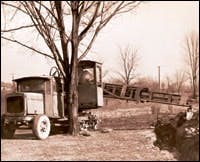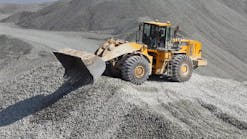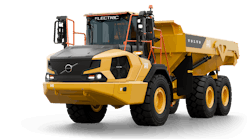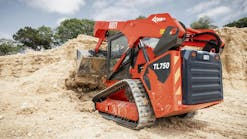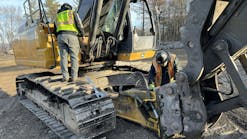Even today, the Gradall excavator remains a unique piece of equipment with its telescopic, rotating boom. And the current configuration is the same in principle as the earliest Gradalls. The excavator traces its roots back to the early 1940s, a time when World War II created a scarcity of laborers for delicate and necessary grading and finishing work on highway projects.
That was the dilemma faced by Ferwerda-Werba-Ferwerda, a Cleveland, Ohio, construction company. Ray and Koop, brothers who had moved to the United States from the Netherlands, were partners in the firm that had become one of the leading highway contractors in Ohio. Because so many men had left the workforce and joined the military, the Ferwerdas set out to create a machine that would save their firm by performing what had been manual slope grading work.
Their first attempt was a device created with two beams set on a rotating platform that was affixed atop a used truck. A telescopic cylinder moved the beams in and out, enabling the fixed blade at the end of the beams to push or pull dirt.
Improving on the design, the brothers created a triangular boom to create more strength, and they added a tilt cylinder that allowed the boom to rotate 45 degrees in either direction. This machine could be equipped with either a blade or bucket, and attachment movement was made possible by placing a cylinder at the rear of the boom, powering a long push rod. Soon afterward, a variety of digging buckets was introduced, available in 15-, 24-, 36- and 60-inch sizes.
The first of these machines was installed in 1941 on a government-surplus truck, becoming the world's first fully hydraulic excavator. The concept was so productive and successful, three more were built on second-hand Linn half-track carriers between 1942 and 1944. The Ferwerdas set out to patent the Gradall concept in 1940. In their patent application, they called it a "material moving device." Probably because of its invention during World War II, the patent application further envisioned military uses such as an ordnance carrier that could scalp the ground surface to position the carrier.
The Ferwerdas built about five excavators by the time they received their patent in 1944, and then began to look for a manufacturer to buy their invention. In its 1945 report to stockholders, Warner & Swasey of Cleveland reported it had purchased the unique earthmover, by then called "the Gradall."
The first model produced by Warner & Swasey was the M-2400 model, introduced in 1946 and mounted like most of the early Gradall units on Army surplus 6×6 trucks. As part of the sale, the Ferwerda family received exclusive distribution rights in parts of Florida, continuing to maintain branch locations in Tampa, Orlando and Miami.
Later sold by Warner & Swasey, what became the Gradall Co. has had many different owners. Currently, Gradall is owned by JLG Industries.
In 1964, Gradall's chief inspector discovered one of the Linn half-track machines in an Akron, Ohio, junkyard. He promptly purchased it for $500, and it was quickly transported to the Gradall plant in New Philadelphia, Ohio, where it was only partially restored to preserve as much of the original machine as possible. For the first time, that Gradall machine was available for public inspection at Conexpo-Con/Agg 2002.
Information supplied by Gradall. If you're interested in historical machines, consider a membership in the Historical Construction Equipment Association. Visit HCEA's website at www.hcea.net.
